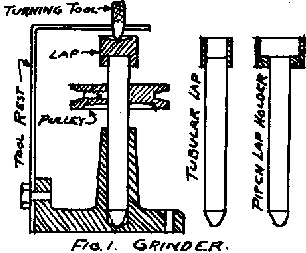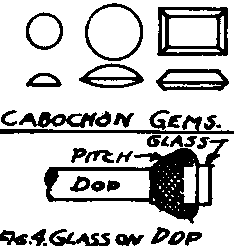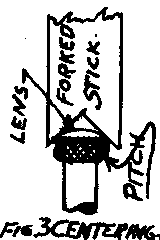Formed laps may be cut directly on the machine with a hand tool. Any motor from 1/10 HP up may be used. The motor pulley should be 1 1/2" and a 3/8" vee belt should be used. Get them from Sears Roebuck or a hardware store. The grinder should be oiled frequently.

 Small lenses may be made from fragments of a spectacle lens or from plate glass from a broken mirror or auto window. Don't try to use non-shatter able glass, as it is not solid glass. If polished glass is used the original surface may form one surface of the lens, thus halving your work of making a lens. Pitch the glass to a stick or "dop" as in Fig. 4. Grind it round, and rough out the curved surface with #2 abrasive (120 grit) and water on either side of the Vee pulley.
Small lenses may be made from fragments of a spectacle lens or from plate glass from a broken mirror or auto window. Don't try to use non-shatter able glass, as it is not solid glass. If polished glass is used the original surface may form one surface of the lens, thus halving your work of making a lens. Pitch the glass to a stick or "dop" as in Fig. 4. Grind it round, and rough out the curved surface with #2 abrasive (120 grit) and water on either side of the Vee pulley.

 If a finished lens is off center, as shown by an edge of varying thickness, it may be centered as follows:- Pitch the lens to the end of a tubular lap slightly smaller than the lens itself, as shown in Fig. 3. Put into the grinder and rotate by hand while you watch the directions of a lighted lamp bulb from the two surfaces of the lens. While the pitch is still quite soft press the lens with the forked stick as in Fig. 3 to adjust it, until both reflections remain stationary as the lap revolves. Remove from the grinder and re-heat if the pitch hardens too quickly. Then start the motor and with a piece of wet emery stone, grind the edge until it runs true. This should make the edge equal all around.
If a finished lens is off center, as shown by an edge of varying thickness, it may be centered as follows:- Pitch the lens to the end of a tubular lap slightly smaller than the lens itself, as shown in Fig. 3. Put into the grinder and rotate by hand while you watch the directions of a lighted lamp bulb from the two surfaces of the lens. While the pitch is still quite soft press the lens with the forked stick as in Fig. 3 to adjust it, until both reflections remain stationary as the lap revolves. Remove from the grinder and re-heat if the pitch hardens too quickly. Then start the motor and with a piece of wet emery stone, grind the edge until it runs true. This should make the edge equal all around.